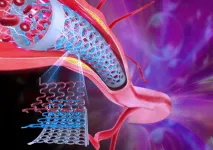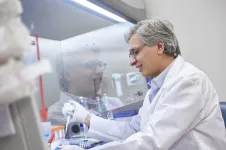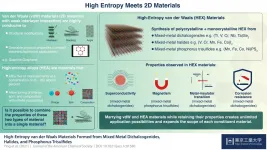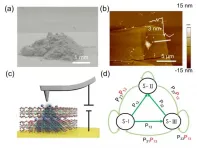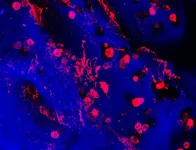(Press-News.org) From the biggest bridges to the smallest medical implants, sensors are everywhere, and for good reason: The ability to sense and monitor changes before they become problems can be both cost-saving and life-saving.
To better address these potential threats, the Intelligent Structural Monitoring and Response Testing (iSMaRT) Lab at the University of Pittsburgh Swanson School of Engineering has designed a new class of materials that are both sensing mediums and nanogenerators, and are poised to revolutionize the multifunctional material technology big and small.
The research, recently published in Nano Energy, describes a new metamaterial system that acts as its own sensor, recording and relaying important information about the pressure and stresses on its structure. The so-called "self-aware metamaterial" generates its own power and can be used for a wide array of sensing and monitoring applications.
The most innovative facet of the work is its scalability: the same design works at both nanoscale and megascale simply by tailoring the design geometry.
"There is no doubt that the next generation materials need to be multifunctional, adaptive and tunable." said Amir Alavi, assistant professor of civil and environmental engineering and bioengineering, who leads the iSMaRT Lab. "You can't achieve these features with natural materials alone--you need hybrid or composite material systems in which each constituent layer offers its own functionality. The self-aware metamaterial systems that we've invented can offer these characteristics by fusing advanced metamaterial and energy harvesting technologies at multiscale, whether it's a medical stent, shock absorber or an airplane wing."
While nearly all of the existing self-sensing materials are composites that rely on different forms of carbon fibers as sensing modules, this new concept offers a completely different, yet efficient, approach to creating sensor and nanogenerator material systems. The proposed concept relies on performance-tailored design and assembly of material microstructures.
The material is designed such that under pressure, contact-electrification occurs between its conductive and dielectric layers, creating an electric charge that relays information about the condition of the material. In addition, it naturally inherits the outstanding mechanical properties of metamaterials, like negative compressibility and ultra-high resistance to deformation. The power generated by its built-in triboelectric nanogenerator mechanism eliminates the need for a separate power source: such material systems can harness hundreds of watts of power at large scales.
A "Game Changer," from the Human Heart to Space Habitats
"We believe this invention is a game changer in metamaterial science where multifunctionality is now gaining a lot of traction," said Kaveh Barri, lead author and doctoral student in Alavi's lab. "While a substantial portion of the current efforts in this area has been merely going into exploring new mechanical properties, we are going a step further by introducing revolutionary self-charging and self-sensing mechanisms into the fabric of material systems."
"Our most exciting contribution is that we are engineering new aspects of intelligence into the texture of metamaterials. We can literally transform any material system into sensing mediums and nanogenerators under this concept," added Gloria Zhang, co-lead author and doctoral student in Alavi's lab.
The researchers have created multiple prototype designs for a variety of civil, aerospace and biomedical engineering applications. At a smaller scale, a heart stent using this design can be used to monitor blood flow and detect signs of restenosis, or the re-narrowing of an artery. The same design was also used at a much larger scale to create a mechanically-tunable beam suitable for a bridge that could self-monitor for defects on its structure.
These materials have enormous potential beyond Earth, as well. A self-aware material uses neither carbon fibers nor coils; it is light in mass, low in density, low in cost, highly scalable, and it can be fabricated using a broad range of organic and inorganic materials. Those qualities make them ideal for use in future space exploration.
"To fully understand the huge potential of this technology, imagine how we can even adapt this concept to build structurally-sound self-powering space habitats using only indigenous materials on Mars and beyond. We are actually looking into this right now," said Alavi. "You can create nano-, micro-, macro- and mega-scale material systems under this concept. That is why I am confident that this invention can build the foundations for a new generation of engineering living structures that respond to the external stimuli, self-monitor their condition, and power themselves."
INFORMATION:
The paper, "Multifunctional meta-tribomaterial nanogenerators for energy harvesting and active sensing" (DOI: 10.1016/j.nanoen.2021.106074), was co-authored by Zhong Lin Wang, PhD, Hightower Chair and Regents' Professor at Georgia Institute of Technology, Jun Chen, PhD, Assistant Professor at Pitt, and Pengcheng Jiao, PhD, Research Professor at Zhejiang University.
This research is supported in part by the NIH under award number R21AR075242-01, and it is a continuation of U.S. Provisional Pat. Ser. No. 63/048943, entitled "Self-aware Composite Mechanical Metamaterials and Method for Making Same," filed at Pitt.
Philadelphia, June 1, 2021--Researchers at Children's Hospital of Philadelphia (CHOP) have developed a proof-of-concept treatment for blood disorders like sickle cell disease and beta-thalassemia that could raise hemoglobin levels by activating production of both fetal and adult hemoglobin. Using a viral vector engineered to reactivate fetal hemoglobin production, suppress mutant hemoglobin, and supply functional adult hemoglobin, the researchers developed an approach that could produce more hemoglobin through a single vector. The results were published in Haematologica.
"Until now, researchers have been exploring one of two approaches to treating blood disorders ...
The discovery of graphene, a 2D layered form of carbon, once caused a paradigm shift in science and technology like no other. As this wonder material drew attention from material scientists around the world, it spurred research on other materials that were structurally similar, such as "van der Waals materials", which comprise strongly-bonded 2D atomic layers that are held together by weak interlayer interactions called "van der Waals forces". These materials quickly caught on because they were highly conducive to structural modifications, such as stacking, twisting, and insertion of foreign molecules between layers, which gave them interesting physical properties ...
Getting enough sleep can be a real challenge for shift workers affecting their overall health. But what role does being an early bird or night owl play in getting good rest? Researchers from McGill University find a link between chronotype and amount of sleep shift workers can get with their irregular schedules.
"Some people seem to be hardwired to sleep early, while others tend to sleep late. This preference, called chronotype, is modulated by our circadian system - each person's unique internal timekeeper," says lead author Diane B. Boivin, a Professor in the Department of Psychiatry at McGill University.
Their study published in Sleep is the first to examine the relationship between ...
Algorism plays a significant role in predicting future states of a system. Particularly, non-Markov chain algorithm has been widely applied in epidemic spreading processes, social and man-made memory networks, the environment-related quantum entangled states, and artificial algorisms such as face pose tracking. Traditionally, a large number of memories and computing cells are integrated to achieve these goals by software algorisms, showing high complexity. In the paper published in Science Bulletin, a group led by Bilu Liu and Hui-Ming Cheng from Tsinghua-Berkeley Shenzhen Institute (TBSI) of Tsinghua University has realized a non-Markov chain algorithm in a single resistive random access memory (RRAM) based on 2D mineral material ...
Swedish researchers from institutions including Uppsala University have spent four years gathering data from the areas affected by the major forest fire of 2014. In their study of how the ecosystem as a whole has been altered, they could see that water quality in watercourses quickly returned to normal, while forested areas continued to lose carbon for many years after the fire.
The consequences of major forest fires remain poorly studied in Northern Europe. To improve this situation, researchers from Uppsala University, the Swedish University of Agricultural Sciences (SLU) and the Swedish Meteorological ...
Siberian jays are group living birds within the corvid family that employ a wide repertoire of calls to warn each other of predators. Sporadically, however, birds use one of these calls to trick their neighbouring conspecifics and gain access to their food. Researchers from the universities of Konstanz (Germany), Wageningen (Netherlands), and Zurich (Switzerland) have now examined how Siberian jays avoid being deceived by their neighbours. The study, published in the journal Science Advances, shows that these birds have great trust in the warning calls from members of their own group, but mainly ignore such ...
News media reports about scientific failures that do not recognize the self-correcting nature of science can damage public perceptions of trust and confidence in scientific work, according to findings by researchers at the Annenberg Public Policy Center (APPC) of the University of Pennsylvania and the University at Buffalo, the State University of New York.
News stories about science follow several specific narratives, the researchers write in a new study in the journal Public Understanding of Science. One is that science is "in crisis" or "broken," a narrative driven in recent years by reports of unsuccessful efforts to replicate findings in ...
A new miniature 3D model of human bone marrow has been described today in the open-access eLife journal.
The model may help clinicians predict which patients will benefit from a new therapy for blood platelet disorders, such as Inherited Thrombocytopenias - a group of familial disorders that inhibit the production of platelets. It could also enable further study of these disorders and give scientists a new tool to test experimental treatments.
Platelets are cells that are necessary for the blood to clot and stop bleeding. Having too few platelets can lead to internal or serious bleeding after surgery or injuries, which is usually treated with therapies that cause clotting. Recent studies have shown that a drug called Eltrombopag increases ...
A college education is estimated to add $1 million to a person's lifetime earning potential, but for some students the path to earning one is riddled with obstacles. That journey is even more difficult for students who have been in the foster care system or experienced homelessness, according to a new study from the University of Georgia.
But the more college administrators and faculty know about these students' problems, the more they can do to ease the burden.
Getting into universities in the first place can frequently be a challenge for students who've had unstable home lives, said David Meyers, co-author of the study.
"Research tells us that every time a student moves from one foster care placement to another, they lose six months of educational ...
In recent months, more than three hundred cases of salmonellosis have occurred in various European countries and Canada, which are linked to each other. In the UK the cases could be partly traced back to frozen breaded poultry meat. The cause was contamination with the bacterium Salmonella Enteritidis, which causes gastrointestinal inflammation. Salmonella is not killed by deep freezing and can remain infectious at temperatures below zero degrees Celsius. The Robert Koch Institute (RKI) and the BfR are monitoring the situation together with the Federal Office of Consumer Protection and Food Safety (BVL). In Germany, the number of reported cases has currently ...
